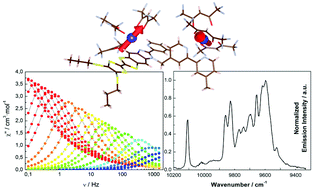Lanthanide complexes involving multichelating TTF-based ligands†
Abstract
The reaction between the 2-{TTF-fused-1H-benzimidazol-2-yl}pyridine alkylated with either the di-(pyrazol-1-yl)-4-pyridyl (L1) or dimethyl-2,2′-bipyridine (L2) moiety and 1 equiv. of Ln(hfac)3·2H2O (LnIII = DyIII and YbIII) leads to three dinuclear complexes of formula [Yb2(hfac)6(L1)]·2(CH2Cl2)·C6H14 (1) and [Ln2(hfac)6(L2)]·CH2Cl2 (LnIII = YbIII (2) and DyIII (3)). The X-ray structures highlight square antiprism (D4d symmetry) and spherical tricapped trigonal prism (D3h) for the eight- and nine-coordinated lanthanide ions, respectively. Irradiation of the lowest-energy HOMO → LUMO ILCT absorption band induced a 2F5/2 → 2F7/2 Yb-centered emission for 1 and 2. Both YbIII ions displayed similar emissions in 2 while two distinct emissions, attributed to the two YbIII ions because of their different coordination environments, were observed in 1. Slow magnetic relaxation is detected by dynamic magnetic measurements for 3 with a measured relaxation time τ0 = 3.7(1.3) × 10−7 s and an energy barrier Δ = 39.6(2) cm−1. Taking into account the environment of both DyIII ions in 3, it was expected that both metallic centers displayed similar dynamic magnetic behavior. The latter was rationalized by ab initio CASSCF/SI-SO calculations.


 Please wait while we load your content...
Please wait while we load your content...